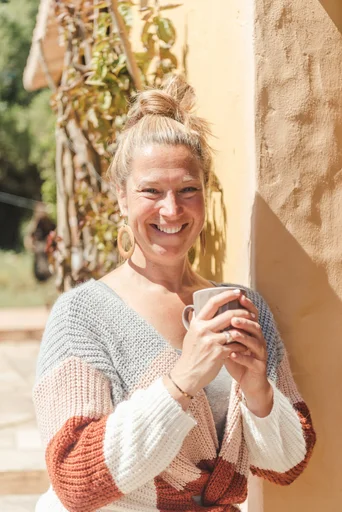5 Ways to Practice Downward-Facing Dog Pose

Introduction to Downward-Facing Dog and Its Benefits
Downward-Facing Dog, also known as Adho Mukha Svanasana in Sanskrit, is a foundational yoga pose with a myriad of benefits for practitioners. This rejuvenating posture involves the body forming an inverted "V" shape, with the hands and feet grounded while the hips are lifted toward the ceiling.
What is Downward-Facing Dog?
This pose stretches and strengthens almost every muscle in the body, making it an excellent full-body workout. It particularly targets the arms, shoulders, hamstrings, calves, and arches of the feet. The elongation of the spine in this pose also helps to relieve tension and improve overall posture.
Why Practice Downward-Facing Dog?
The practice of Downward-Facing Dog offers numerous physical and mental benefits. It strengthens the upper body, including the arms and shoulders, which is beneficial for individuals looking to enhance their upper body strength. Additionally, it may help improve digestion by stimulating abdominal organs and aiding in detoxification processes within the body.
Moreover, this pose can help stimulate circulation throughout the body, potentially reducing leg pain and ankle discomfort. The shoulder joints can also benefit from this posture as it may help strengthen them over time.
Furthermore, regular practice of Downward-Facing Dog may contribute to reducing body mass index (BMI), which is an indicator of obesity. It can also aid in lowering the chances of organ dysfunction related to hypertension by promoting healthy blood flow throughout the body.
Additionally, incorporating this pose into your yoga routine may help relieve difficulty in inhaling due to mucus presence while improving immunity from within. This posture serves as a reset for the spine between strong backbends and forward bends while providing stress-relieving benefits.
1. Mastering the Basics
As you embark on your journey to master the Downward-Facing Dog pose, it's crucial to prioritize proper alignment and technique. Achieving the correct alignment not only ensures a safe practice but also maximizes the benefits of this foundational yoga pose.
Finding the Right Alignment
When practicing Downward-Facing Dog, paying attention to hand and feet placement is essential for stability and balance. Your hands should be shoulder-width apart, firmly pressing into the mat, while your fingers are spread wide to distribute weight evenly. Similarly, your feet should be hip-width apart, allowing for a strong foundation as you lift your hips toward the ceiling.
Engaging your core is another fundamental aspect of this pose. By activating your abdominal muscles, you create a supportive center that helps prevent overarching in the lower back and promotes spinal elongation.
Expert Testimony:
Use Shawn Radcliffe, a yoga expert, emphasizes that improper execution of Downward-Facing Dog can lead to potential injuries in various parts of the body, including the back, neck, shoulders, arms, wrists, and legs.
Tips to Avoid Common Mistakes
One common mistake to avoid is overarching the back, which can strain the spine and lead to discomfort. Instead, focus on lengthening through the spine while keeping a gentle engagement in the lower abdomen to support your lower back.
Additionally, it's important to keep the neck relaxed during this pose. TINT teacher Young Ho Kim advises against allowing the shoulders to collapse or draw away from the ears. Instead, actively lift your shoulders toward your ears and bring your ears close to your biceps by pushing into the ground.
By prioritizing proper alignment and avoiding common mistakes, you can lay a strong foundation for mastering Downward-Facing Dog and reaping its full benefits.
2. Enhancing Your Practice with Props

As you delve deeper into your practice of the Downward-Facing Dog pose, you may find that incorporating props can significantly elevate your experience and provide valuable support. Utilizing props can enhance stability, promote proper alignment, and assist in deepening the stretch within this foundational yoga posture.
Using Blocks for Stability
Blocks are versatile props that can aid in achieving optimal alignment and stability during your practice of Downward-Facing Dog. Placing blocks under your hands allows you to bring the ground closer to you, especially if reaching the floor feels challenging. This modification reduces strain on the wrists and upper body, making the pose more accessible while maintaining its integrity.
Moreover, blocks can serve as a valuable tool for individuals working on finding the correct distance between their hands and feet. By using blocks to support proper alignment, practitioners can focus on elongating through the spine and engaging the core without compromising form or risking injury.
Incorporating blocks into your practice fosters a sense of security and empowerment, enabling you to explore the pose with confidence as you gradually build strength and flexibility.
The Role of a Yoga Strap
A yoga strap is another beneficial prop that supports practitioners in refining their alignment and deepening their stretch in Downward-Facing Dog. This versatile tool assists in maintaining arm and shoulder integrity by providing gentle traction while preventing overextension.
By utilizing a yoga strap, individuals with limited flexibility or those working towards more profound openings in the shoulders and hamstrings can find greater ease in this posture. The strap offers an extended reach for clasping hands behind the back, fostering a sensation of spaciousness across the chest while encouraging proper shoulder positioning.
Furthermore, a yoga strap promotes mindful engagement of the arms and shoulders while allowing practitioners to experience a full extension through the spine. It serves as a bridge to gradually progress towards a deeper expression of Downward-Facing Dog while honoring individual anatomical differences.
Incorporating props such as blocks and yoga straps into your practice cultivates an environment of exploration and self-discovery, empowering you to embrace variations that cater to your unique needs while nurturing a sustainable practice.
3. Incorporating Breathing Techniques
The Importance of Breath in Yoga
In the practice of yoga, the breath is a fundamental element that intertwines with movement, creating a harmonious flow of energy and mindfulness. Downward-Facing Dog offers an opportunity to synchronize breath with physical exertion, enhancing the overall experience and benefits of this rejuvenating pose.
One particularly impactful breathing technique to integrate into your practice of Downward-Facing Dog is Ujjayi Breathing. This pranayama technique involves breathing slowly and deeply through the nose while slightly constricting the back of the throat, resulting in a soft whispering sound resembling ocean waves.
Scientific Research Findings:
A 2012 study published in the Journal of Clinical and Diagnostic Research revealed that Ujjayi Breathing stimulates the vagus nerve, suppresses sympathetic nervous system activity, and turns off the physical response to stress.
Furthermore, a 2013 study conducted by the National Center for Biotechnology Information demonstrated that Ujjayi Breathing contributes to better blood pressure control, improved oxygen saturation, and reduced anxiety.
By incorporating Ujjayi Breathing into your practice of Downward-Facing Dog, you can tap into its potential to calm the mind, regulate heart rate, and cultivate a sense of inner peace. This intentional breath work not only enhances focus but also encourages a deeper connection between body and mind during your yoga practice.
Synchronizing Breath and Movement
As you transition into Downward-Facing Dog, aligning your breath with each movement fosters a sense of fluidity and grace. Inhale deeply as you prepare to transition into the pose, feeling your chest expand as you lengthen through your spine. As you exhale, engage your core muscles and lift your hips toward the ceiling while maintaining steady breath awareness.
This synchronization creates a rhythmic pattern that supports stability and mindfulness throughout the pose. By consciously linking breath with movement, you can elevate your experience of Downward-Facing Dog, promoting a deeper stretch while fostering mental clarity and presence on the mat.
Incorporating intentional breathing techniques into your yoga practice enriches not only physical aspects but also mental well-being. Embracing this holistic approach allows for a more profound exploration of self-awareness and inner balance within each posture.
4. Adjusting the Pose for Your Body

As you progress in your practice of Downward-Facing Dog, it's essential to explore modifications and variations that cater to your unique needs, allowing you to adapt the pose to your body's current capabilities and limitations.
Modifications for Beginners
For individuals new to practicing Downward-Facing Dog, incorporating modifications can help reduce strain on the wrists and upper body while promoting proper alignment and posture.
Bending the Knees
One beginner-friendly modification involves gently bending the knees while in Downward-Facing Dog. This adaptation reduces the load on the hamstrings and allows practitioners to focus on elongating through the spine and maintaining a neutral pelvis. By bending the knees, individuals can gradually build strength in their upper body and core, laying a solid foundation for progressing into the traditional expression of this rejuvenating pose.
Elevating the Hands
Another beneficial adjustment for beginners is elevating the hands by using yoga blocks or other supportive props. Placing blocks under the hands creates additional space between the shoulders and wrists, reducing pressure on these areas while fostering a more comfortable experience. Elevating the hands also facilitates better alignment, enabling practitioners to focus on engaging their core muscles and lengthening through the spine without compromising stability.
Advanced Variations
As you advance in your yoga journey, exploring advanced variations of Downward-Facing Dog can offer new challenges and opportunities for growth.
Adding a Twist
Incorporating a gentle twist into Downward-Facing Dog can enhance spinal mobility and promote a deeper stretch throughout the back, shoulders, and obliques. This variation involves rotating one shoulder towards the opposite knee while maintaining a strong foundation with your hands and feet grounded. The twist not only encourages greater flexibility but also stimulates circulation and energy flow within the body, revitalizing your practice.
Lifting One Leg
For experienced practitioners seeking an added challenge, lifting one leg while in Downward-Facing Dog can elevate both physical strength and mental focus. This variation requires engaging core stability to maintain balance while deepening the stretch in the standing leg. Lifting one leg also fosters heightened awareness of body alignment and breath control, offering a dynamic exploration of this foundational yoga pose.
By embracing modifications for beginners and exploring advanced variations as you progress in your practice, you can tailor Downward-Facing Dog to suit your individual needs while continually expanding your capabilities on the mat.
5. Consistency and Patience in Practice
Setting Realistic Goals
In the practice of yoga, setting realistic goals plays a pivotal role in nurturing a sustainable and fulfilling journey. Establishing achievable milestones allows practitioners to progress steadily while honoring their current abilities and limitations. When approaching the Downward-Facing Dog pose, it's essential to set intentions that align with your unique body and mind, fostering a sense of purpose and direction in your practice.
Begin by identifying specific aspects of the pose that you aim to improve or refine. Whether it's enhancing upper body strength, deepening the stretch in the hamstrings, or focusing on breath awareness, delineating clear objectives provides clarity and motivation throughout your yoga journey.
Moreover, consider incorporating a consistent practice schedule into your routine, dedicating regular time to explore and refine your experience with Downward-Facing Dog. Consistency fosters gradual progression while allowing for ample opportunities to observe growth and development in both physical capabilities and mental resilience.
Embracing patience as an integral component of your practice journey is equally crucial. Understand that each individual's path is unique, and progress unfolds at its own pace. Cultivate self-compassion and acceptance as you navigate through challenges and plateaus, recognizing that every step forward contributes to your overall growth.
By setting realistic goals aligned with your personal aspirations and embracing patience as a guiding virtue, you can approach the Downward-Facing Dog pose with intentionality and perseverance.
Celebrating Progress
Amidst the pursuit of refining your practice of Downward-Facing Dog, celebrating progress serves as a source of encouragement and motivation along the way. Acknowledge each milestone achieved, whether it's maintaining steadier alignment, deepening the breath-body connection, or experiencing increased ease in the pose.
Reflect on how far you've come since initiating your journey with this foundational yoga posture. Recognize the dedication, effort, and commitment invested in honing your skills while remaining open to continuous learning and exploration.
Furthermore, consider documenting your progress through journaling or reflective practices. By recording observations about your experiences with Downward-Facing Dog, you create an opportunity for self-reflection and insight into your evolving relationship with this rejuvenating pose.
Engage in positive self-talk and affirmations that reinforce the value of consistent effort and dedication. Embrace a mindset that celebrates incremental advancements while embracing imperfections as integral parts of the learning process.
Ultimately, celebrating progress cultivates a supportive environment within yourself—a space where self-appreciation thrives alongside ongoing growth within your yoga journey.
Conclusion: Embracing the Journey
As I reflect on the transformative nature of Downward-Facing Dog, I am reminded of its profound capacity to guide us along the path of self-improvement. This foundational yoga pose serves as a mirror, offering insights into our physical and mental landscapes while nurturing a sense of resilience and adaptability. Embracing the journey with Downward-Facing Dog invites us to explore its diverse expressions, each unveiling unique opportunities for growth and self-discovery.
The practice of this rejuvenating pose encourages us to approach challenges with a renewed perspective, fostering resilience in the face of adversity. It serves as a reminder that discomfort can be transformed into comfort through mindful breath and intentional movement, instilling a sense of calm amidst life's complexities.
Testimonials:
Use bold for the person's name or position.
Unknown
Blockquotes for the testimonial text.
"I love downward-facing dog. It turns my world around, immediately changing perspective about the challenging issues in life, calming the thinking brain, and over time in my asana (pose) practice, it feels quite comforting."
"Oh Downward Dog! Let me count the ways you have changed and continue to change. You are a shape shifter and a magical mirror."
As we navigate our practice with Downward-Facing Dog, let us draw inspiration from these words and embrace the evolving nature of this pose. Encountering its variations allows us to cultivate adaptability and openness, fostering an environment where exploration is celebrated and individuality is honored.
Encouragement and Support
In your journey with Downward-Facing Dog, remember that every iteration of this pose holds value, whether it aligns with its classic form or manifests uniquely within your body. Embrace each expression wholeheartedly, acknowledging that every variation offers an opportunity for personal growth.
Allow yourself to be guided by curiosity and compassion as you navigate through different manifestations of this rejuvenating posture. Find encouragement in knowing that your dedication to consistent practice cultivates resilience while nurturing a deeper connection between mind, body, and breath.
Amidst challenges encountered along this journey, extend support to yourself with kindness and patience. Celebrate every step forward—no matter how small—as an affirmation of your commitment to growth within your yoga practice.
Embracing the journey with Downward-Facing Dog encompasses not only physical exploration but also an inward voyage towards self-awareness and acceptance. As we honor our unique experiences with this foundational pose, may we find solace in its transformative potential while embracing encouragement from within.
See Also
Enhance Your Practice with 4 Powerful Mudras
13 Poses for Chair Yoga Practice
Yoga Poses for Beginners: Expert Recommendations
Relieve Low Back Pain with 5 Psoas-Releasing Prenatal Yoga Poses
We bring back the importance of initiation into womanhood by Roos-Veerle Krijnen & Ella-June Henrard
Welcome to the Women’s Initiation Retreat by Naked Truth Retreats, a transformative journey into the depths of your True Feminine Nature. This retreat, scheduled from 17th to 24th August 2024 in Portugal, invites you to remember the sacredness and wholeness of your being.
Roos-Veerle Krijnen & Ella-June Henrard



